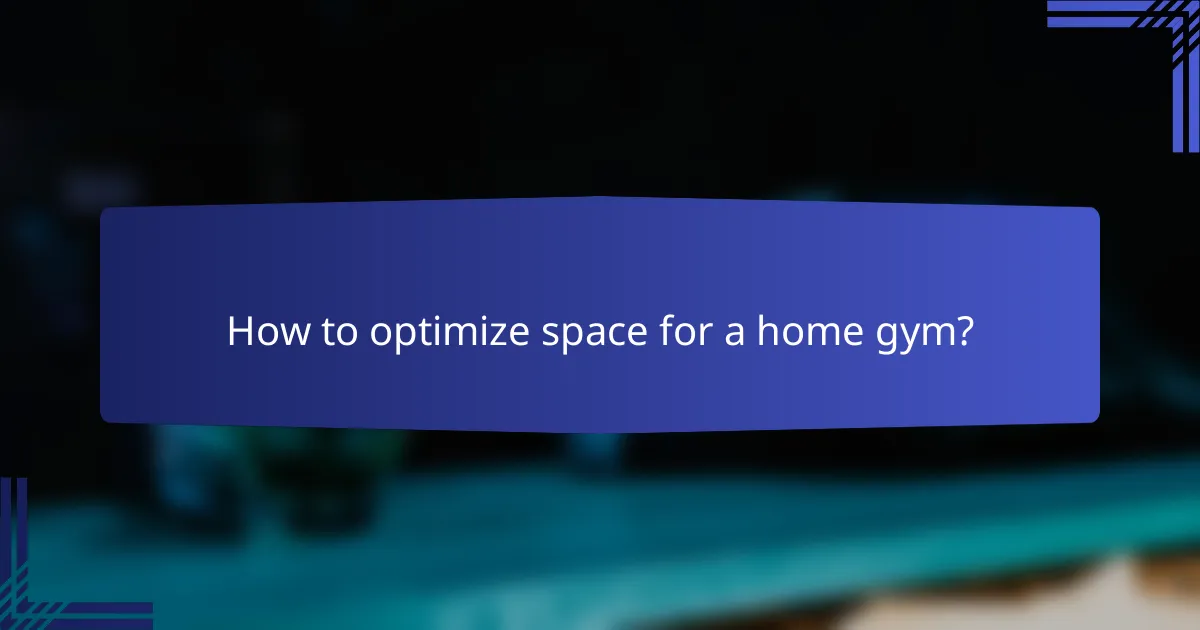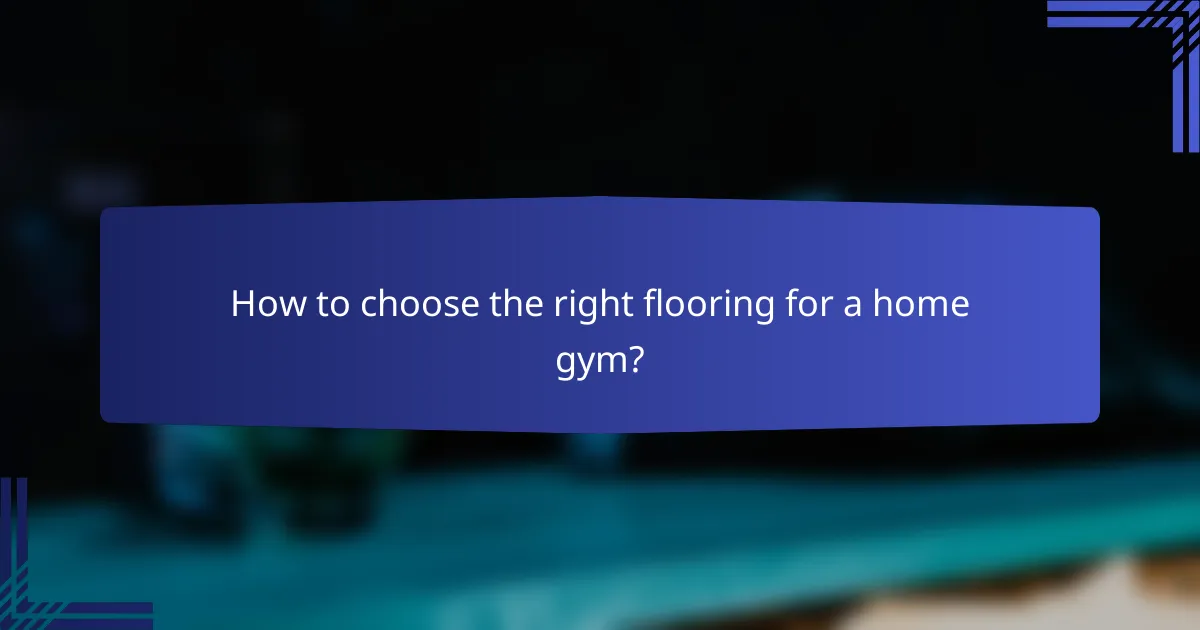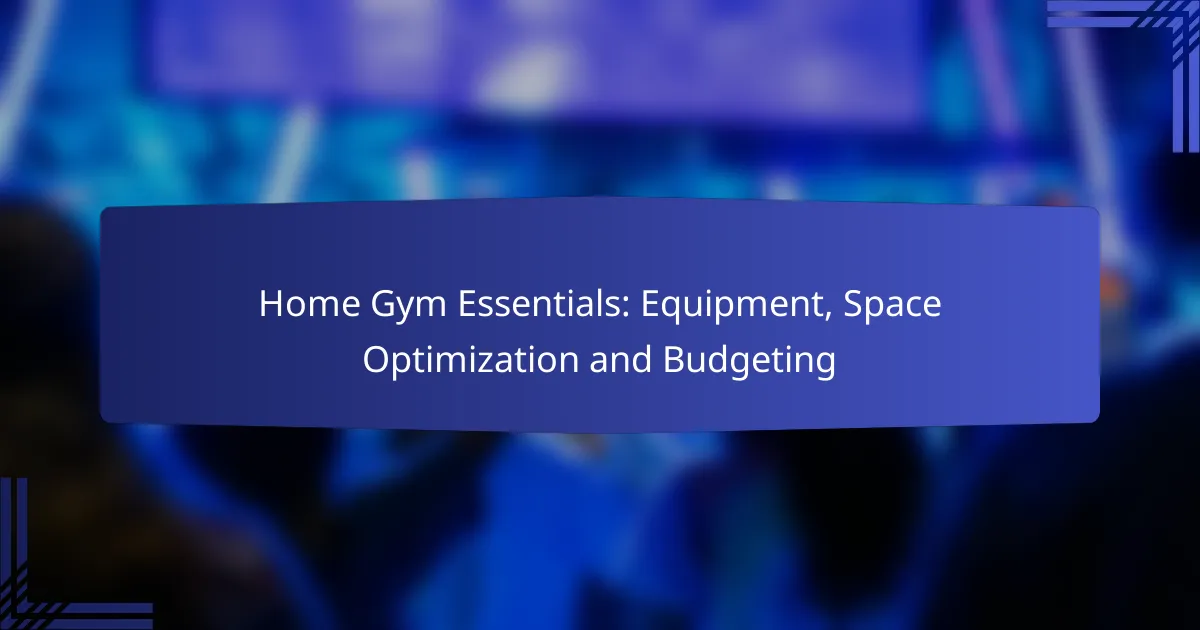Creating a home gym can be an empowering step towards achieving your fitness goals, and it starts with selecting essential equipment that caters to a variety of exercises. By optimizing your space with versatile tools and efficient storage solutions, you can enhance your workout experience while keeping your environment organized. Additionally, budgeting wisely will ensure you invest in quality equipment that meets your needs without overspending.

What home gym equipment is essential for beginners?
For beginners, essential home gym equipment includes versatile tools that allow for a range of exercises, focusing on strength, flexibility, and cardiovascular fitness. Key items like dumbbells, resistance bands, a yoga mat, an adjustable bench, and a cardio machine can create a well-rounded workout space.
Dumbbells
Dumbbells are a fundamental piece of equipment for strength training, offering a range of weights to suit different fitness levels. They can be used for various exercises targeting multiple muscle groups, making them ideal for beginners looking to build strength.
When selecting dumbbells, consider starting with a set that includes lighter weights, typically ranging from 2 kg to 10 kg (4 lbs to 22 lbs), as this allows for gradual progression. Adjustable dumbbells can also be a space-saving option, providing multiple weight settings in one compact design.
Resistance bands
Resistance bands are an excellent addition to any home gym, providing resistance for strength training without the bulk of weights. They come in various levels of resistance, making them suitable for all fitness levels.
Look for a set that includes bands of different thicknesses, allowing you to adjust the resistance as you progress. They are lightweight, portable, and can be used for a wide range of exercises, including strength training and stretching.
Yoga mat
A yoga mat is essential for providing a comfortable and non-slip surface for floor exercises, stretching, and yoga practices. It enhances stability and safety during workouts, especially when performing movements that require balance.
Choose a mat that is at least 6 mm thick for adequate cushioning and support. Mats made from eco-friendly materials are also available, which can be a consideration for environmentally conscious individuals.
Adjustable bench
An adjustable bench is a versatile piece of equipment that allows for various exercises, including bench presses, step-ups, and seated workouts. Its ability to incline or decline makes it suitable for targeting different muscle groups effectively.
When selecting a bench, ensure it can support your weight and has a sturdy frame. Look for one that is easy to adjust, allowing you to switch positions quickly during workouts.
Cardio machine
A cardio machine, such as a treadmill, stationary bike, or elliptical, is crucial for improving cardiovascular fitness. These machines offer a convenient way to get your heart rate up and can be used year-round, regardless of weather conditions.
Consider your space and budget when choosing a cardio machine. Treadmills and stationary bikes typically range from a few hundred to several thousand USD, depending on features and quality. Look for machines that offer adjustable settings and built-in workout programs to keep your routine engaging.

How to optimize space for a home gym?
To optimize space for a home gym, focus on efficient storage solutions, versatile equipment, and clearly defined workout areas. This approach maximizes functionality while minimizing clutter, making your workouts more enjoyable and effective.
Use wall-mounted storage
Wall-mounted storage is a practical solution for keeping your home gym organized and maximizing floor space. Consider installing shelves, racks, or hooks to store weights, resistance bands, and other small equipment. This not only keeps items off the ground but also makes them easily accessible during workouts.
When selecting wall-mounted options, ensure they are sturdy enough to hold the weight of your equipment. Look for adjustable shelving systems that can adapt as your fitness needs change, allowing you to customize your storage over time.
Choose multi-functional equipment
Multi-functional equipment can significantly reduce the amount of space needed for your home gym. Items like adjustable dumbbells, resistance bands, or a squat rack that doubles as a pull-up bar provide various workout options without requiring separate machines. This versatility allows for a full-body workout in a compact area.
Investing in quality multi-use equipment can save money and space in the long run. Prioritize items that offer different weight settings or can be easily transformed for various exercises, ensuring you get the most out of your investment.
Designate a specific area
Designating a specific area for your home gym helps create a focused environment that encourages regular workouts. Choose a space that is well-ventilated and has enough room for your equipment and movement. Ideally, this area should be free from distractions to enhance your exercise experience.
To further optimize this space, consider using mats or flooring designed for exercise to protect your floors and provide comfort. Keep the area tidy by regularly organizing your equipment and ensuring everything has a designated spot, making it easier to maintain your workout routine.

What is the budget for setting up a home gym?
Setting up a home gym typically requires a budget ranging from a few hundred to several thousand dollars, depending on the equipment and space you choose. Key considerations include the type of workouts you plan to do, the quality of the equipment, and any additional features you may want in your gym space.
Average costs of equipment
The average costs of gym equipment can vary widely. Basic items like dumbbells and resistance bands may cost between $50 to $200, while larger machines like treadmills or stationary bikes can range from $300 to over $2,000. For a well-rounded setup, expect to budget around $500 to $1,500 for essential equipment.
Consider purchasing second-hand equipment to save money. Many people sell lightly used machines at a fraction of the original price, which can significantly reduce your overall costs.
Budgeting tips for home gyms
To effectively budget for your home gym, start by listing the essential equipment you need and prioritize your purchases. Focus on versatile items that allow for a variety of workouts, such as adjustable dumbbells or a multi-gym machine.
Set a realistic budget based on your financial situation and stick to it. Avoid impulse buys by researching prices and waiting for sales or discounts. Creating a spreadsheet can help you track your expenses and stay within your budget.
Financing options for gym equipment
If upfront costs are a concern, consider financing options available through retailers or third-party lenders. Many fitness equipment stores offer payment plans that allow you to spread the cost over several months, making it more manageable.
Another option is to use a credit card with a 0% introductory APR on purchases. This can provide a temporary solution to finance your equipment without incurring interest, as long as you pay off the balance before the promotional period ends.

What are the best brands for home gym equipment?
The best brands for home gym equipment combine quality, durability, and a range of options to suit various fitness needs. Popular choices include Bowflex, Peloton, and NordicTrack, each offering unique features and benefits that cater to different workout preferences.
Bowflex
Bowflex is well-known for its innovative strength training equipment, particularly its adjustable dumbbells and home gym systems. Their products often feature compact designs, making them suitable for smaller spaces while still providing a comprehensive workout experience.
When considering Bowflex, look for models that offer a variety of resistance levels and workout programs. This flexibility allows users to progress at their own pace, which is essential for effective strength training.
Peloton
Peloton has gained popularity for its high-quality stationary bikes and interactive fitness classes. Their equipment is designed to provide an immersive workout experience, with live and on-demand classes that cater to various fitness levels.
Investing in Peloton means not just purchasing a bike but also committing to a subscription service for access to classes. This can be a significant ongoing cost, so it’s important to evaluate your budget and workout preferences before making a decision.
NordicTrack
NordicTrack is recognized for its diverse range of cardio equipment, including treadmills, ellipticals, and bikes. Their machines often come equipped with advanced technology, such as interactive touchscreens and adjustable inclines, enhancing the workout experience.
When choosing NordicTrack, consider the warranty and service options, as well as the variety of workouts available through their iFit subscription. This can provide additional motivation and structure to your fitness routine, making it easier to stay on track.

How to choose the right flooring for a home gym?
Selecting the right flooring for a home gym is crucial for safety, comfort, and functionality. Consider factors such as durability, ease of maintenance, and the types of exercises you will perform to make an informed choice.
Rubber flooring benefits
Rubber flooring is a popular choice for home gyms due to its excellent shock absorption and durability. It provides a non-slip surface, reducing the risk of injuries during workouts. Additionally, rubber is easy to clean and can withstand heavy equipment without damage.
Another advantage of rubber flooring is its sound-dampening properties, which can help minimize noise during workouts. This is particularly beneficial in multi-level homes or shared living spaces. Rubber flooring is available in various thicknesses, typically ranging from 1/4 inch to 1 inch, allowing you to choose based on your specific needs.
Carpet vs. vinyl options
Carpet can offer a softer surface for exercises like yoga or Pilates, but it may not provide the same level of durability or ease of cleaning as rubber. Vinyl flooring, on the other hand, is water-resistant and comes in a variety of styles, making it a versatile option for home gyms. It can mimic the look of wood or tile while being more affordable and easier to maintain.
When comparing carpet and vinyl, consider the type of workouts you plan to do. For high-impact activities, vinyl or rubber may be preferable, while carpet could be suitable for low-impact exercises. Ultimately, your choice should reflect your workout routine, budget, and aesthetic preferences.
